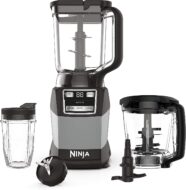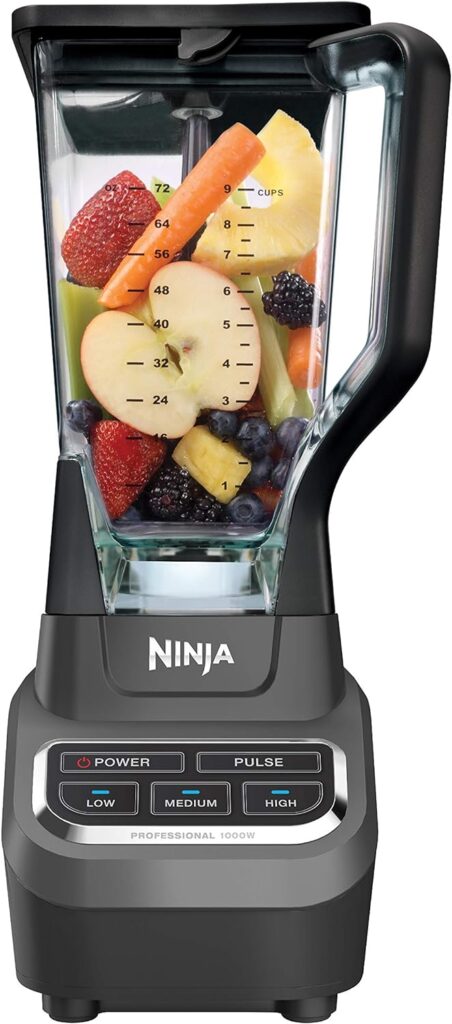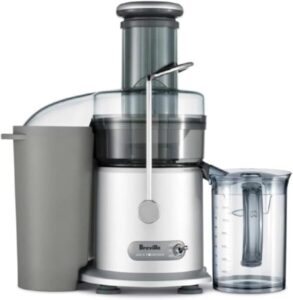In modern kitchens, deciding between essential tools like a blender vs juicer vs mixer which not only enhance culinary creativity but also support healthier lifestyles and save time, can be confusing.
While it may be easy to see the obvious difference between a blender and mixer, and the difference between a blender and juicer, but there are several not so obvious differences between all three appliances.
This article explores the differences and capabilities of these kitchen tool and provides description, primary uses, key features, types, functionality and advantages of each appliance.
Amazon Canada (AMZ.ca) serves as a prime resource for these appliances, offering a broad selection, detailed customer reviews, and competitive pricing. Make informed choices to suit your culinary needs with this detailed guide..
Understanding Each Appliance – Blender vs Juicer vs Mixer
Each kitchen appliance serves specific purposes and is designed with particular tasks in mind. Blenders and juicers, along with mixers, while often grouped together, have unique functions that cater to different culinary activities.
Each of these appliances plays a critical role in modern kitchens, streamlining various cooking processes and enhancing the culinary experience.
Whether blending, juicing, or mixing, understanding the functions and types available can guide consumers in choosing the right tool for their needs, especially when browsing through the vast options available on Amazon Canada with a limited budget.
Here’s a breakdown of each appliance:
Blenders
Blenders are versatile appliances designed to blend, puree, and emulsify food. Their primary function is to create smooth textures from solid ingredients by rapidly spinning them with sharp blades. Blenders are commonly used to liquefy ingredients for making smoothies, soups, and sauces.
Key Features
- Powerful Motors: To handle hard ingredients like frozen fruit and ice.
- Variable Speed Controls: Allowing for precise blending to achieve the desired texture.
- Pulse Feature: Helps to manage the blending of tougher items without overprocessing.
- Durable Pitchers: Usually made from glass or high-strength plastic that can withstand the stress of spinning blades.
Variation of these key features result in the differences between blender models which result in different performance levels.
Juicers
Juicers are designed to extract juice from fruits and vegetables, separating it from the pulp. They are ideal for creating beverages that are rich in vitamins and minerals. Juicers can vary widely in their mechanisms and efficiency.
Features of Different Types of Juicers
Centrifugal Juicers: These juicers grind fruits and vegetables into pulp through a high-speed spinning action. They are fast and easy to use but may not be as efficient in extracting all the juice or preserving nutrients.
Masticating Juicers (Slow Juicers): These operate at slower speeds and crush the food against a screen, which results in higher juice yields and more nutrients being preserved due to less heat and oxidation.
Mixers
Mixers are essential for any baking process, designed to mix, beat, and knead ingredients. From whipping cream to kneading dough, mixers make these tasks efficient and less labor-intensive.
Features and Types of Mixers
Stand Mixers: Equipped with a bowl and varying attachments, stand mixers are powerful and can handle large quantities of ingredients. They are suitable for frequent baking and more complex recipes.
Hand Mixers: More compact and handheld, these mixers are convenient for smaller tasks like beating eggs or mixing batter. They offer portability and easy storage.
Comparing Functionality of Blenders and Juicers vs Mixers
Understanding the difference between a blender and a juicer, and the difference between a blender and mixer and how they process food and the specific results they produce is helpful. It allows you to appreciate the distinct advantages each offers in food preparation because each appliance caters to different needs and outcomes, enhancing the kitchen’s versatility.
PROS – Advantages of Blenders in Food Preparation
Blenders use a combination of sharp blades and a high-speed motor to chop, blend, and puree ingredients. The blades create a vortex, pulling food items downwards and blending them into a smooth consistency.
This method is effective for breaking down both soft and hard components, making blenders extremely versatile.
- Versatility: Blenders can handle a wide range of ingredients, from frozen fruits and vegetables to nuts and seeds.
- Consistency: They are excellent for creating uniformly smooth textures, essential for soups, smoothies, and purees.
- Speed: Most blenders can achieve desired textures in minutes, making them ideal for quick meal prep.
PROS – Advantages of Juicers in Food Preparation
Juicers extract juice by separating the liquid from the fibers and pulp. Centrifugal juicers do this through a high-speed spinning action that forces the juice out through a mesh filter. Masticating juicers, on the other hand, use a slow crushing and pressing motion to extract juice more efficiently, preserving more nutrients.
- Nutrient Extraction: Juicers are designed to provide a concentrated dose of nutrients by extracting only the juice, which is easily absorbed by the body.
- Flavor Enhancement: By removing fiber, juicers produce a more concentrated flavor from fruits and vegetables.
- Variety: They can accommodate a wide range of raw ingredients, from leafy greens to hard vegetables.
PROS – Advantages of Mixers in Food Preparation
Mixers primarily use mixing attachments like beaters or dough hooks that rotate to combine ingredients uniformly. Stand mixers offer a stationary mixing action with attachments that spin and orbit. Hand mixers, on the other hand provide you with the mobility to mix ingredients across different spots in a bowl.
- Efficiency in Baking: Mixers excel in tasks that require aerating, like whipping cream or beating eggs, which are labor-intensive by hand.
- Dough Preparation: They are ideal for kneading bread or pizza dough, which can be physically demanding without a mixer.
- Consistency and Texture: Mixers ensure that ingredients are evenly mixed, crucial for the texture and success of baked goods.
Each appliance (blender vs juicer vs mixer) offers unique benefits and operates with distinct mechanisms, making them suitable for specific tasks in the kitchen.
Health Benefits of Blender vs Juicer vs Mixer Appliances
Blenders, juicers, and mixers each contribute uniquely to a healthy lifestyle and kitchen efficiency. Here’s how each appliance benefits users both in health and time-saving aspects:
Blenders
- Nutrient Retention: Blenders process foods without removing any part of the ingredient, retaining all the fiber and nutrients.
- Dietary Diversity: They make it easy to incorporate a variety of fruits, vegetables, and proteins into your diet through smoothies, soups, and shakes.
- Healthy Options: Homemade blends can be customized for nutritional needs, avoiding added sugars and preservatives found in store-bought products.
- Efficiency and Time-Saving Aspects:
- Quick Preparation: Blenders are ideal for quick meals like smoothies and soups, significantly cutting down meal preparation time.
- Ease of Use: Simple controls and straightforward operation make blenders user-friendly for all skill levels.
- Versatile Uses: Capable of multiple functions, blenders reduce the need for other appliances for grinding or mixing.
Juicers
- Enhanced Nutrient Absorption: Juicers extract high concentrations of vitamins and minerals from fruits and vegetables, which are easier for the body to absorb as liquid.
- Increased Fruit and Vegetable Intake: Juicing encourages higher consumption of fruits and vegetables, supporting overall health.
- Detoxification: Fresh juices can help support detoxification processes in the body due to their high nutrient and enzyme content.
- Efficiency and Time-Saving Aspects:
- Quick Nutrient Consumption: Juicing offers a rapid way to consume nutrients without the need for lengthy cooking or preparation.
- Specialized Performance: Juicers efficiently process large amounts of produce to maximize juice yield, saving time and effort in manual extraction.
- Ease of Incorporation into Diet: Juices are easy to incorporate into daily meals, especially for those on-the-go.
Mixers
- Homemade Quality: Mixers enable the preparation of homemade baked goods and dishes, which are healthier than store-bought versions filled with additives and preservatives.
- Control Over Ingredients: Users have complete control over what goes into their mix, allowing for healthier, allergen-free options tailored to dietary restrictions.
- Efficiency and Time-Saving Aspects:
- Labor Saving: Mixers take over the physically demanding tasks of stirring, beating, and kneading, which are time-consuming when done manually.
- Consistency and Speed: They provide consistent results much faster than hand mixing, crucial for baking that relies on precise textures.
- Multi-Functionality: With various attachments, mixers can serve multiple functions from whipping to dough kneading, eliminating the need for additional tools and speeding up the cooking process.
Each of these appliances not only contributes to a healthier diet by facilitating the preparation of nutrient-rich foods but also enhances kitchen efficiency, making cooking and meal preparation quicker and more enjoyable.
How to Choose the Right Appliance – Blender vs Juicer vs Mixer
When selecting between a blender vs juicer vs mixer, several key factors should guide your decision to ensure the appliance matches your cooking habits and lifestyle needs
By carefully considering these aspects, you can choose an appliance that not only fits your kitchen space but also enhances your cooking experience and aligns with your health and lifestyle goals.
| 🍹 Factors to Consider in Choosing Between a Blender vs Juicer vs Mixer 🥣 | |
|---|---|
1. Purpose and Usage |
Consider what you’ll primarily use the appliance for. Blenders are ideal for smoothies and soups, juicers for extracting pure juices, and mixers for baking and cooking tasks. |
2. Space and Convenience |
Evaluate your kitchen space. Stand mixers are larger, while blenders and juicers require less space. |
3. Frequency of Use |
Think about how often you will use the appliance. Daily juicing, for instance, justifies investing in a robust and efficient juicer. |
4. Match the Appliance with Cooking and Lifestyle Needs |
|
| Created by Metamorphosishub.com | |
Popular Models
Amazon Canada offers a wide array of kitchen appliances, including blenders, juicers, and mixers. Some of the top-rated and popular models based on customer reviews and ratings are presented below, highlighting their standout features.
Blenders
Vitamix E310 Explorian Blender: Known for its powerful motor and durability, this blender can handle everything from smoothies to hot soups. It features variable speed control and a large 48 – ounce capacity container. It is self-cleaning – with a drop of dishwashing liquid and warm water, this machine cleans itself in 30 to 60 seconds. Vitamix blenders are pricey, but are typically high on performance and durability. This model is one of the less pricey ones.
Ninja Professional Blender BL610: If you are looking for something more affordable than a Vitamix, this hugely popular model is favored for its affordability and powerful performance, with a 1000-watt motor and a 72-ounce pitcher.
It is ideal for crushing ice and blending fruits and vegetables smoothly. The blender includes a safety feature that keeps the blades from spinning unless the lid is secured.
The Ninja BL610 receives high marks for its value for money, with users appreciating its ease of use and cleaning.
Juicers
Breville JE98XL Juice Fountain Plus: A centrifugal juicer that is fast and easy to use, featuring an 850-watt motor and an extra-wide chute that accommodates whole fruits and vegetables. The Breville JE98XL is highly regarded for its speed and efficiency, with many users noting its ability to produce high-quality juice quickly.
Omega NC900HDC Juicer Extractor and Nutrition Center: A masticating juicer that operates at low speeds to minimize heat build-up and oxidation, maximizing nutrient extraction and enzyme retention. Creates fruit, vegetable and wheatgrass juice.
The Omega NC900HDC is lauded for its effective juice extraction and quiet operation, making it a favorite among health-conscious consumers. It provides value for the cost.
Mixers
KitchenAid Artisan Series 5-Qt. Stand Mixer – KSM150PSER: A staple in many kitchens, this mixer comes with various attachments, including a dough hook and a whisk, suitable for many culinary tasks.
This Mixer is often celebrated for its reliability and versatility, with many reviewers mentioning its ability to handle a wide range of baking and cooking tasks effortlessly.
Hamilton Beach 63325 6-Speed Stand Mixer: Offers great performance with a 300-watt motor and includes similar attachments to the KitchenAid, but at a more budget-friendly price point.
The Hamilton Beach model is appreciated for providing good functionality at a lower cost, with some users highlighting its performance as comparable to more expensive brands.
Whether blending, juicing, or mixing, these appliances offer functionality and reliability, as reflected in their excellent customer reviews and ratings.
Technical Specifications and Price Range
Deciding whether to choose between high-end and budget models of blenders and juicers, or mixers requires an understanding of their technical specifications and how these contribute to the differences in prices.
Technical Specifications
Power and Motor Efficiency: High-end models often feature more powerful motors, which translate to better performance and durability. For instance, premium blenders like the Vitamix might offer 1500 watts or more, whereas budget blenders may operate around 500-800 watts.
Material Quality: Higher-priced items typically use more durable materials such as stainless steel or heavy-duty polycarbonate, whereas budget models might use less durable plastics.
Additional Features: High-end appliances may include features like multiple speed settings, digital interfaces, or special attachments that contribute to versatility and convenience.
Price Range and Impact of Added Features
Blenders: Budget models can range from $30 to $100, suitable for basic blending tasks. Premium models, especially those designed for more intense use or specific culinary tasks, can cost anywhere from $200 to $600.
Juicers: A basic centrifugal juicer might cost around $50 to $150, while advanced masticating juicers that offer better nutrient extraction can range from $200 to $500.
Mixers: Stand mixers start around $100 for basic models but can go up to $500 or more for high-end versions with additional features like a larger capacity or more powerful motor.
The price increases with the inclusion of advanced technology, higher quality materials, and additional features that enhance performance and durability. Understanding these aspects can help buyers decide which specifications are worth paying for, based on their specific needs and budget.
Cons to Watch Out For – Blender vs Juicer vs Mixer
Major cons include durability and price. Keep in mind that cheapest or the most expensive products are not necessarily the best. Carefully review the various factors in this guide before you make your selection.
Maintenance and Durability
Proper maintenance of kitchen appliances like blenders and juicers, and mixers is key for their longevity and performance. Here are some tips for maintaining each type of appliance and insights into their expected durability based on personal insight, and consumer reviews.
| 🛠️ Maintenance Tips and Expected Durability 🕒 | |
|---|---|
Maintenance Tips |
Blenders: Regularly clean all parts after use, especially the blades and gasket, to prevent residue build-up. Most blender parts are dishwasher safe, but hand washing can increase longevity. Ensure the base and motor are kept dry and clean. Juicers: Clean juicer components immediately after use to avoid pulp and residue hardening. Screens and filters should be brushed to remove fiber deposits, which can affect performance over time. Mixers: After each use, wipe down the mixer and clean any attachments. Periodically check and adjust, if possible, the beater to bowl clearance to ensure efficient mixing. |
Expected Durability |
Blenders: High-quality blenders typically last around 5-10 years, depending on the brand and usage. Models like Vitamix and Ninja are noted for their long-lasting durability when properly maintained. Juicers: Durability varies significantly between centrifugal and masticating juicers. Masticating juicers generally last longer (up to 15 years) due to their slower speeds reducing motor wear. Centrifugal juicers often have a lifespan of about 5-8 years. Mixers: Stand mixers, particularly from brands like KitchenAid, are known for their robust construction and can last over a decade. Hand mixers generally have a shorter lifespan, around 3-5 years, depending on the frequency of use and quality. |
| Created by Metamorphosishub.com | |
Maintaining any kitchen appliances such as blenders and juicers according to manufacturer instructions and handling them with care greatly enhances their longevity, ensuring they remain dependable kitchen aids for many years. User reviews consistently highlight the importance of regular maintenance in extending the life of these appliances.
Conclusion – Blender vs Juicer vs Mixer
Throughout this exploration of the difference between a blender and a juicer and the difference between a blender and a mixer, we have looked into their unique functions, benefits, and the key considerations for choosing the right appliance.
Each serves distinct purposes in the kitchen, from blending smooth concoctions to extracting nutrient-rich juices and aiding in complex baking tasks. The choice between these appliances should be guided by individual culinary needs, space considerations, and lifestyle preferences.
This guide helps you eliminate the confusion surrounding blenders and juicers, along with mixers so that you can make make informed decisions to enhance your cooking experience and match your dietary goals.
Related Article
FAQ
Which appliance is best for making smoothies – Blender vs Juicer?
Blenders are ideal for smoothies due to their ability to blend whole fruits and vegetables, retaining fiber and nutrients. Juicers extract juice, removing fiber, while mixers are suited for other culinary tasks
Are food processors better appliances to buy than individual blenders, juicers or mixers?
Food processors offer versatility by combining functions of blenders, juicers, and mixers. They chop, slice, shred, and blend, making them a comprehensive kitchen tool. However, for specialized tasks like juicing or baking, dedicated appliances may be preferred for optimal results




